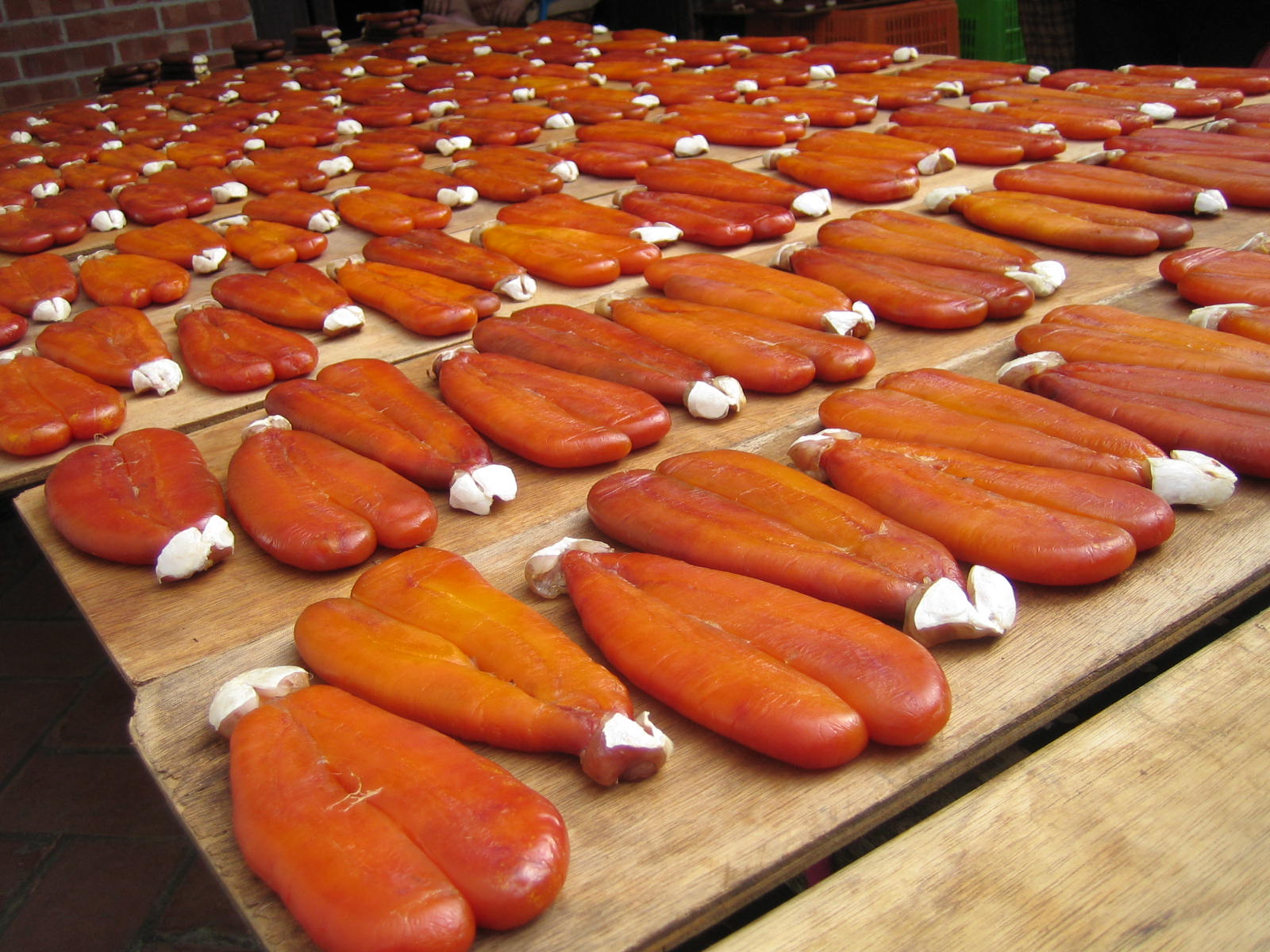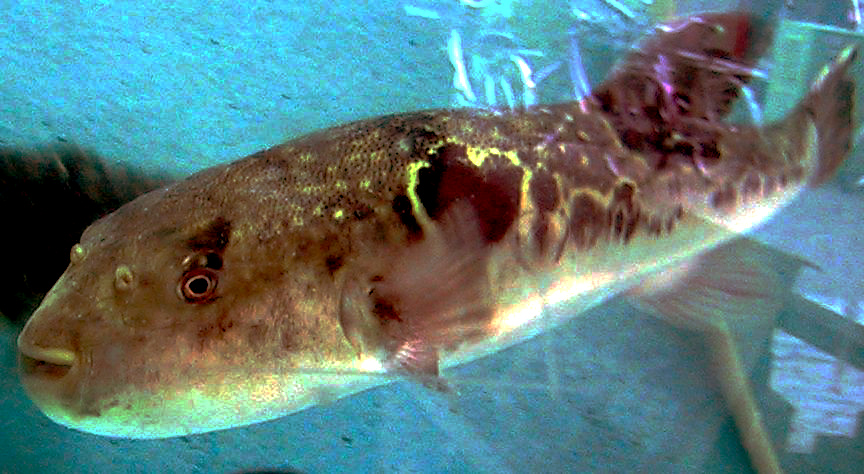|
Chinmi
{{Nihongo, Chinmi, 珍味 is a Japanese term meaning literally "rare taste", but more appropriately "delicacy". They are local cuisines that have fallen out of popularity or those cuisines that are peculiar to a certain area. Many involve pickled seafood. List of ''chinmi'' Hokkaidō area * ''Hizunamasu'' * ''Ikanankotsu'' - Cooked soft bones of squid * ''Kankai'' - Dried ''saffron cod, Komai'' fish. It may be eaten as is, or broiled and eaten with a sauce made by mixing mayonnaise and soy sauce and sprinkles of red pepper powder. * Kirikomi * Matsumaezuke * Mefun * ''Saketoba'' - A smoked salmon * ''Tachikama'' * Sea urchin, Uni Tōhoku area * ''Awabi no Kimo'' - Ground internal organs of abalone * ''Donpiko'' - The heart of a salmon. As only one can be taken from a fish, it is very rare. * ''Hoya'' - sea pineapple * ''Momijizuke'' - Shreds of fresh salmons and Ikura pickled together * Tonburi - A speciality of Akita Prefecture, Akita prefecture. The dried seeds of the ''Ko ... [...More Info...] [...Related Items...] OR: [Wikipedia] [Google] [Baidu] |
Delicacy
A delicacy is usually a rare and expensive food item that is considered highly desirable, sophisticated, or peculiarly distinctive within a given culture. Irrespective of local preferences, such a label is typically pervasive throughout a region. Often this is because of unusual flavors or characteristics or because it is rare or expensive compared to standard staple foods. Delicacies vary per different countries, customs and ages. Flamingo tongue was a highly prized dish in ancient Rome, but is not commonly eaten in modern times. Lobsters were considered poverty food in North America until the mid-19th century when they started being treated, as they were in Europe, as a delicacy. Some delicacies are confined to a certain culture, such as fugu in Japan, bird's nest soup (made out of swiftlet nests) in China, and ant larvae ( escamoles) in Mexico or refer to specific local products, such as porcino, venison or anchovy. Examples of delicacies * Abalone (Bao Yu/Jeonbo ... [...More Info...] [...Related Items...] OR: [Wikipedia] [Google] [Baidu] |
Ankimo
is a Japanese dish made with monkfish liver. The liver is first rubbed with salt, then rinsed with sake. Then its veins are picked out and the liver is rolled into a cylinder and steamed. ''Ankimo'' is often served with ''momiji-oroshi'' ( chili-tinted grated daikon), thinly sliced scallions and ponzu sauce. ''Ankimo'' is considered one of the ''chinmi'' (delicacies) of Japan. It is listed at number 32 on ''The World's 50 Best Foods'' compiled by ''CNN Go''. Preparations Ankimo is most often consumed outside of Japan as sushi or sashimi. Inside Japan, ankimo is used in several meibutsu, regional delicacies, such as dobu-jiru, stewed ankimo and vegetables from Fukushima. See Also * Chinmi * Meibutsu is a term most often applied to regional specialties (also known as ). can also be applied to specialized areas of interest, such as , where it refers to famous tea utensils, or Japanese swords, where it refers to specific named famous blades. ... References {{Reflis ... [...More Info...] [...Related Items...] OR: [Wikipedia] [Google] [Baidu] |
Mullet Roe By Comicpie In Taiwan
Mullet, mullets, The Mullet or The Mullets may refer to: Fish * Mullet (fish), or "grey mullet", of the family Mugilidae **Flathead grey mullet, or striped mullet, ''Mugil cephalus'', a food fish species in the family Mugilidae * Goatfish, or "red mullet", of the family Mullidae; in particular, red mullet of the genus ''Mullus'' * Malagasy mountain mullet, ''Acentrogobius therezieni'', a species of fish in the family Gobiidae endemic to Madagascar * Pearl mullet, ''Chalcalburnus tarichi'', a species of ray-finned fish in the family Cyprinidae native to Turkey * Shorthead redhorse, ''Moxostoma macrolepidotum'', a freshwater fish of North America, also known as common mullet, mullet, redhorse mullet Hairstyle * Mullet (haircut), a hairstyle that is short in the front, top, and sides, but long in the back Media * ''Mullet'' (film), a 2001 Australian film * ''The Mullets'', a UPN TV sitcom * Mullets (comic strip), a short-lived comic strip Places * Mullet, Albania, a village ... [...More Info...] [...Related Items...] OR: [Wikipedia] [Google] [Baidu] |
Daitokuji Natto ''
{{disambiguation ...
Daitokuji may refer to: * Daitoku-ji, a Buddhist temple in Japan * Lyman Banner, a character in ''Yu-Gi-Oh! GX'', known as Professor Daitokuji in Japan * B-ko Daitokuji, a character in the 1986 Japanese anime film ''Project A-ko is a 1986 Japanese action comedy science fiction anime film that had several sequels and a spin-off. This film focuses on a happy-go-lucky 16-year-old red-haired, sailor-suited teenage schoolgirl, A-ko Magami, who goes on her magical adventure ... [...More Info...] [...Related Items...] OR: [Wikipedia] [Google] [Baidu] |
Kinki
The or the , lies in the southern-central region of Japan's main island Honshū. The region includes the prefectures of Nara, Wakayama, Kyoto, Osaka, Hyōgo and Shiga, often also Mie, sometimes Fukui, Tokushima and Tottori. The metropolitan region of Osaka, Kobe and Kyoto (Keihanshin region) is the second-most populated in Japan after the Greater Tokyo Area. Name The terms , , and have their roots during the Asuka period. When the old provinces of Japan were established, several provinces in the area around the then-capital Kyoto were collectively named Kinai and Kinki, both roughly meaning "the neighbourhood of the capital". Kansai (literally ''west of the tollgate'') in its original usage refers to the land west of the Osaka Tollgate (), the border between Yamashiro Province and Ōmi Province (present-day Kyoto and Shiga prefectures).Entry for . Kōjien, fifth edition, 1998, During the Kamakura period, this border was redefined to include Ōmi and Iga Provinces. It i ... [...More Info...] [...Related Items...] OR: [Wikipedia] [Google] [Baidu] |
Konowata
, is a food in Japanese cuisine made from various marine animals that consists of small pieces of meat in a brown viscous paste of the animal's heavily Table salt, salted, fermentation (food), fermented viscera. The raw viscera are mixed with about 10% salt, 30% Aspergillus oryzae, malted rice, packed in a closed container, and fermented for up to a month. ''Shiokara'' is sold in glass or plastic containers. The flavor is similar in saltiness and fishiness to that of European cured anchovies, but with a different texture. One of the best-known ''chinmi'' ("rare tastes"), it is quite strong and is considered something of an acquired taste even for the native Japanese palate. It was a valuable protein in post-war Japan because food was scarce and it did not require refrigeration. It continued to be eaten as a condiment for rice and in bars. One method of enjoying it is to consume the serving in one gulp and to follow it with a shot of straight whisky. Some bars in Japan speciali ... [...More Info...] [...Related Items...] OR: [Wikipedia] [Google] [Baidu] |
Inago No Tsukudani
Inago no tsukudani (いなごの佃煮) is a Japanese dish featuring rice grasshoppers that are boiled in soy sauce and sugar. ''Inago'' is the Japanese word for locust. The locusts are prepared in the "tsukudani" style of cooking (boiled in soy sauce and sugar). The dish is traditional in Japan's inland and mountain regions, including Nagano and Fukushima, where it once served as an important nutritional supplement. Background Locusts have been regarded as natural enemies of agricultural crops since ancient times because of their ability to swarm, which can lead to plagues. There is no way of avoiding this phenomenon other than decreasing the number of locusts before they swarm. People suffered from locust plagues because the locusts left them with nothing to eat after they swarmed; thus, people started to eat them. Because they contain a large amount of protein Proteins are large biomolecules and macromolecules that comprise one or more long chains of amino acid resid ... [...More Info...] [...Related Items...] OR: [Wikipedia] [Google] [Baidu] |
Ika No Maruboshi
Ika may refer to: *Ika, Akwa Ibom, a Local Government Area in Nigeria *Ika, Croatia, a town in Primorje-Gorski Kotar County, Croatia *Ika language (Colombia), also known as Arhuaco *Ika language (Nigeria) *Ika people, of Nigeria *Ika people (Colombia) *Enrique Ika (c. 1859–after 1900), king of Easter Island *Tehran Imam Khomeini International Airport, Tehran, Iran *Ika Musume, the main character from the Japanese manga ''Squid Girl'' See also *IKA (other) *ICA (other) ICA or ica may refer to: Places * Ica, Peru, a city in southern Peru ** Ica Province, containing the city *** Ica Region, containing the province ** Ica River, passing through the city * Içá River, Brazil, also known as the Putumayo River, a t ... {{disambiguation, geo, surname Language and nationality disambiguation pages ... [...More Info...] [...Related Items...] OR: [Wikipedia] [Google] [Baidu] |
Fugu No Ranso No Nukazuke
The fugu (; ; ) in Japanese, ''bogeo'' (; 鰒魚) or ''bok'' () in Korean, and ''hétún'' (河豚; 河魨) in Standard Modern Chinese is a pufferfish, normally of the genus ''Takifugu'', ''Lagocephalus'', or ''Sphoeroides'', or a porcupinefish of the genus ''Diodon'', or a dish prepared from these fish. Fugu can be lethally poisonous to humans due to its tetrodotoxin, meaning it must be carefully prepared to remove toxic parts and to avoid contaminating the meat. The restaurant preparation of fugu is strictly controlled by law in Japan and several other countries, and only chefs who have qualified after three or more years of rigorous training are allowed to prepare the fish. Domestic preparation occasionally leads to accidental death. Fugu is served as sashimi and nabemono. The liver was served as a traditional dish named ''fugu-kimo'', being widely thought to be a tasty part, but it is also the most poisonous, and serving this organ in restaurants was banned in Japan in 1984 ... [...More Info...] [...Related Items...] OR: [Wikipedia] [Google] [Baidu] |




